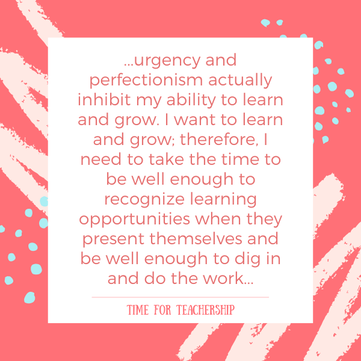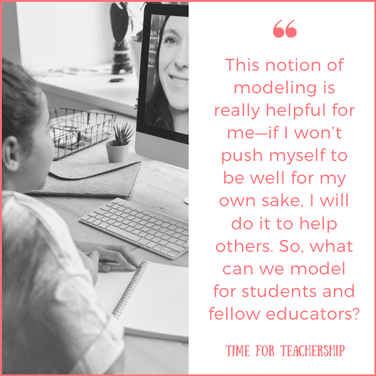|
Last week, I took a week off of the blog for the first time since December. It was my attempt to practice boundaries and self-care to continue the collective care work. The day I was scheduled to take off? I worked all day. My rational brain understands taking the time to rest and recharge is necessary to sustain my energy for the important work we do, but there are several mindsets I continue to struggle with—mindsets that hold me back from putting this understanding into practice. In this post, I want to share a behind-the-scenes look at the struggles that often prevent me from striking a work-life balance. I hope you do not recognize these mindsets in yourself, but if you do, you are not alone. Side note: I intentionally use the phrase “work-life balance” because while I think there are interesting elements of Struggle #1: I Tell Myself “I Can’t Afford the Time Off” Being my own boss, I have the great privilege of setting my own schedule. However, I’ve found I rarely let myself take time off. I tell myself I can’t press pause on the things I have going on. Last week, for example, I took a week off of blog writing, which freed up about a day’s worth of work. I scheduled my day off. One day. I had been physically ill for several weeks, I hadn’t been sleeping or eating well, and I still couldn’t value the importance of my mental and physical health over the tasks that could wait another week or take a week off. The rational part of my brain says, “The late night comedy shows I watch have been taking time off. I should follow their lead!” But I tell myself my work can’t wait. Ha! I’ve been learning more about white supremacy culture, and the sense of urgency that I need to get everything done now and do it all perfectly are two aspects of white supremacy culture. Maintaining these mindsets of urgency and perfectionism actually inhibit my ability to learn and grow. I want to learn and grow; therefore, I need to take the time to be well enough to recognize learning opportunities when they present themselves and be well enough to dig in and do the work to grow in those moments. Struggle #2: I Can’t Put My Brain in Vacation Mode That one day off? I ended up working a full 10-hour day. Something came up that needed to be done, but I know myself. I would have been thinking about work most of the day anyways. I struggle to turn my work brain off. In some ways, this can be helpful. I like randomly thinking up ideas for new units when I’m going for a run or doing something non-work related. That’s a part of work-life integration I can get behind. But, I struggle to simply “be,” and I recognize that’s a problem. It has always been a struggle for me. I’ve gotten sucked into the fast-paced, work-centered culture we live in. Recently, I’ve been scheduling 15 minutes of mindfulness into each day. I use the Stop Think Breathe app on my phone to spend some time paying attention to my body and my breath, and I have created a separate work “log in” on my laptop to create a digital “door” to my virtual office space. My identity has always been tied to my work, and I don’t think that, in and of itself, is harmful. It’s part of that passion and drive I feel to do the work I do, but when I don’t give myself the proper space and time to relax, it also takes a pretty big mental and physical toll. I’m still working on overcoming this struggle, and I don’t think it’s realistic to expect I’ll never think of work when I’m taking time off, but I do think it’s possible to get to the point of recognizing the work thoughts as I have them and perhaps writing down ideas or reminders if I need to, so that I can stop fixating on work and let the thoughts leave my mind until the next work day. Struggle #3: “I Must Be Constantly Available” On my days off, all I want to do is stay very far away from my computer because my computer—as a result of working from home in a one-bedroom apartment—is the physical representation of my workplace. I know I feel better when I can completely separate from my workplace, but any time I step away, I feel like I am somehow failing the amazing community of educators who may be counting on me for a quick response to an email or a Facebook message. This was the same mindset I struggled with as a high school teacher—what if my students are emailing me with a question and I don’t answer it until tomorrow? I thought that would make me a total failure as a teacher! (I hope you’re able to laugh at me because you see how ridiculous this idea is, but I really believed it.) What helped me with this was seeing my principal model these boundaries. She would let everyone know they needed to go home and be home and there was zero expectation of checking email because she would not be checking her email. A few times over the years, I was frustrated that she was unavailable, thinking I needed an immediate answer to something, but in each of the situations I thought required an immediate response, it didn’t. I was able to adapt and make it work. I realized that her insistence on email and vacation boundaries were far more helpful to me than a quick response to a single question. She was modeling healthy boundaries. Modeling Healthy Living Many of us integrate SEL practices into our classes because we know students need to be socially and emotionally well to thrive. This has become even more relevant during the pandemic. This notion of modeling is really helpful for me—if I won’t push myself to be well for my own sake, I will do it to help others. So, what can we model for students and fellow educators? Urgency & Perfectionism. Flexible deadlines helped me model for students that while we need to get things done, I didn’t want my students having a mental breakdown because they were so stressed about a due date. Some assignments, like public presentations, had a deadline that could not be altered, and students knew they needed to meet it. Other assignments that were submitted to me had somewhat arbitrary deadlines that I set, and I could afford to be flexible if it helped a student’s mental wellness. I’ll be writing more on perfectionism in my next post, but as a teacher, I found I had a great opportunity to model how to overcome perfectionism. First, when I would make a mistake (because of course I would, I’m human), I would apologize, and I would let students see that being perfect is far less important than how you respond when you make a mistake. Vacation Brain. Many of our students (two-thirds by age 16) have experienced some form of trauma. Taking just a minute or two of my class each day for mindful breathing helped me and my students build our capacities to simply “be”. One day, after doing our 30-seconds of breathing time, a student thanked me and said “I never have time to just breathe.” I saw myself in her comment, and I realized we all needed to continue this practice. Another way I tried to support students in embracing vacation brain was not assigning homework over vacation. (Some students liked to use vacation time to get a jumpstart on projects, so I would often share what we would be doing when we returned from vacation, so students could do work if they wanted, but there was no pressure to complete any assignment for the first day back.) We all need that break. Being Constantly Available. I was fortunate to have an administrator who modeled healthy boundaries for me and respected the ones I set for myself. As a teacher, I realized, in setting and sticking to boundaries of my own, I could model healthy practices for my students in the same way my principal modeled this for me. My students grew used to the fact that I didn’t respond immediately to email, and they learned to figure things out for themselves or wait until we were back in class to ask. For this last piece to work effectively (in other words, to prevent students from experiencing high levels of stress while waiting on my response), I had to be flexible in my deadlines for assignments and make space during class for students to work on whatever they needed to work on. This flexibility was necessary for the boundaries to work, but it came with another host of benefits—opportunities for more 1:1 or small group meetings with students, additional chances for me to give in-the-moment formative feedback, and students generally experiencing less stress and more agency regarding their work. Personally, I often struggle to overcome these challenges because I add too much to my plate. Saying “No” is difficult, but I will continue to work on doing it better. In fact, I’d like to shift my focus from what gets a “No” response, to what, as a result of the "No"s can finally get a “Yes”. Jenna Kutcher says when she says no, she frames it by saying: Here are my current priorities, and I have to say no because it doesn’t fit with my priorities at this time. I like that frame because it provides a rationale (although, to be clear, we don’t need to rationalize our “No”s) and we are also modeling for others how they can say “No” themselves. For reminders about this, I’m re-sharing my boundary reminders printables. Click the button below to grab them and put them in your workspace.
1 Comment
Kris
8/13/2020 09:33:14 pm
Thank you for sharing. I believe this is something most teachers struggle with.
Reply
Leave a Reply. |
Details
For transcripts of episodes (and the option to search for terms in transcripts), click here!
Time for Teachership is now a proud member of the...AuthorLindsay Lyons (she/her) is an educational justice coach who works with teachers and school leaders to inspire educational innovation for racial and gender justice, design curricula grounded in student voice, and build capacity for shared leadership. Lindsay taught in NYC public schools, holds a PhD in Leadership and Change, and is the founder of the educational blog and podcast, Time for Teachership. Archives
May 2024
Categories |





 RSS Feed
RSS Feed